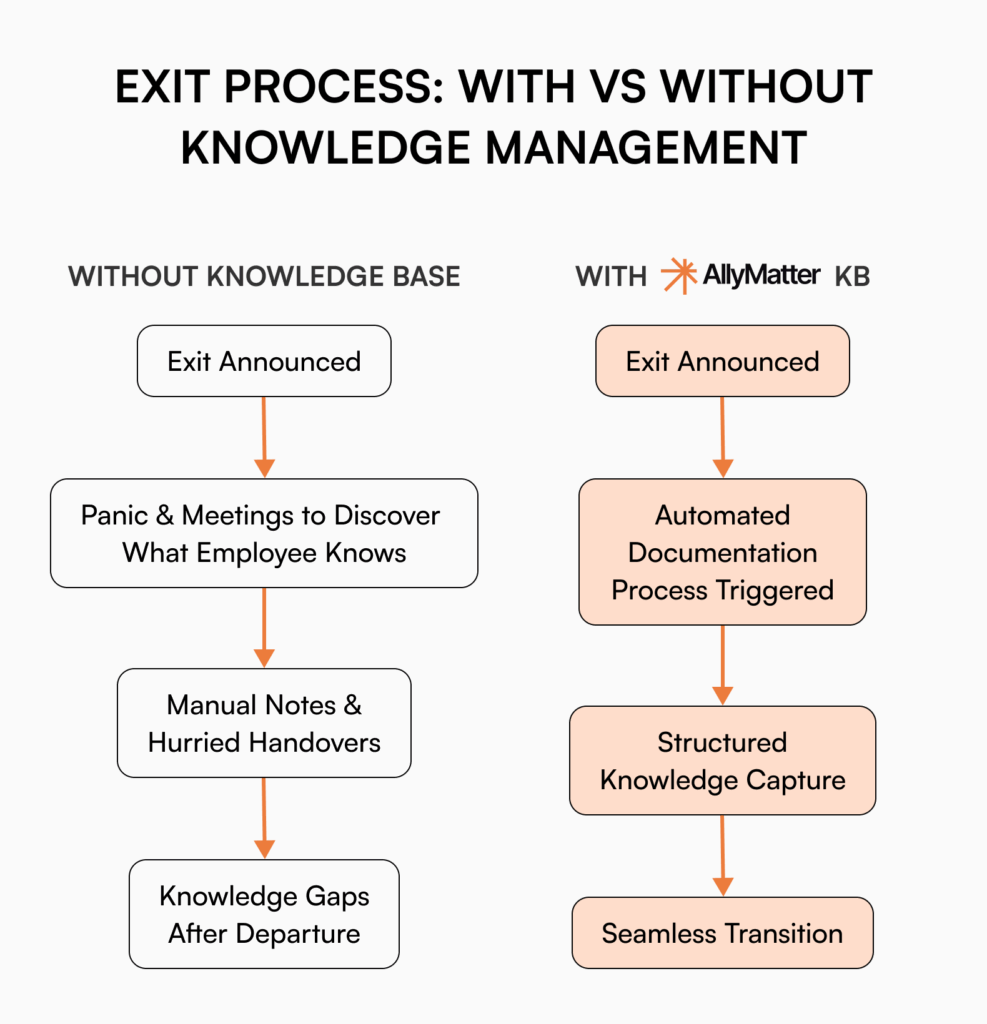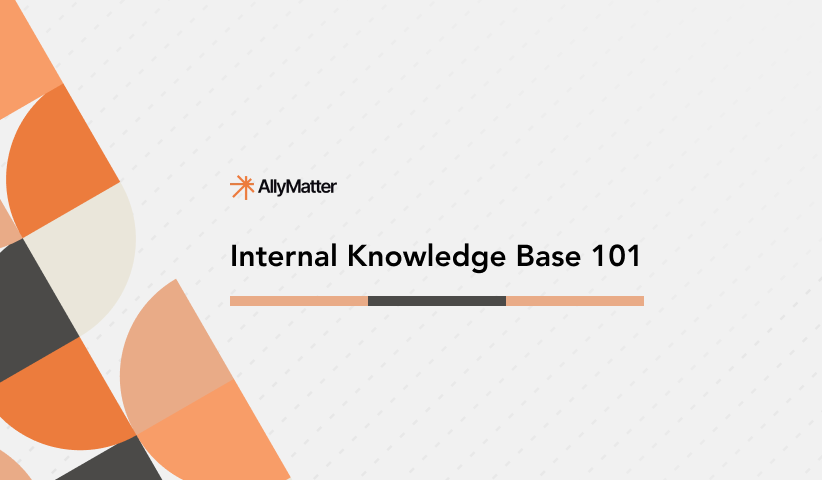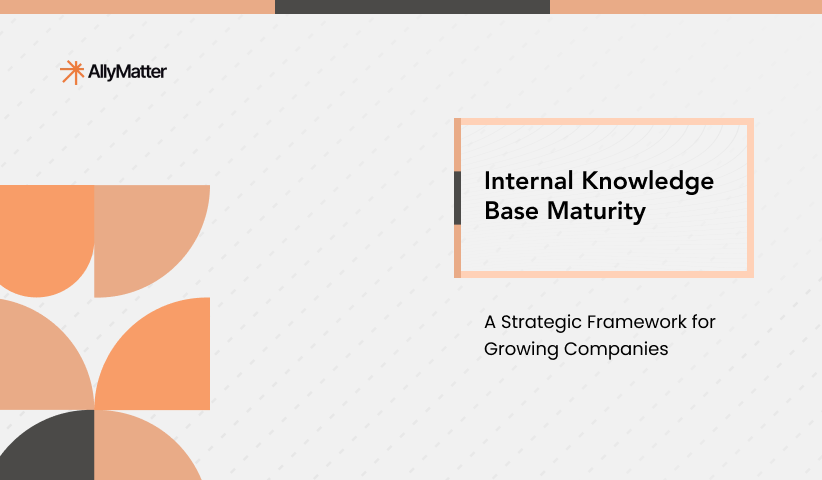We’ve all been there. A key team member announces they’re leaving, and suddenly you’re scrambling to capture years of experience before their last day. Whether it’s your star developer who built your entire codebase or your operations lead who manages all vendor relationships, exits happen in every organization.
What shouldn’t happen is the mass exodus of critical knowledge when people walk out the door.
In growing companies, departures come in many forms: planned resignations, sudden exits, internal transfers, or even unexpected circumstances like illness. Without a structured way to preserve institutional wisdom, each scenario creates ripples of disruption that can last months.
What exit documentation actually means (and why it’s more than paperwork)
When most leaders hear “exit documentation,” they think of the basics: final paychecks, signed NDAs, and equipment return forms. But true exit documentation encompasses so much more; it’s about business continuity, not just HR compliance.
Comprehensive exit documentation includes:
- Project handovers with context and history
- Standard operating procedures that might live only in someone’s head
- Access credentials and authorization processes
- Client and vendor relationship details
- Undocumented workarounds and solutions to recurring problems
Consider what happens without proper documentation: A software developer leaves without explaining the API architecture they built. An HR manager departs with customized onboarding workflows saved only in their email drafts. An operations leader exits without documenting special vendor arrangements they’ve negotiated.
Each scenario doesn’t just create inconvenience; it creates genuine business risk.
The hidden cost of undocumented exits
The price of poor knowledge transfer during exits often remains invisible until it’s too late. When knowledge walks out the door, the consequences ripple throughout your organization:
Operational downtime increases as remaining team members struggle to piece together how things work. A task that took the departing employee minutes might take the new hire hours or days without proper documentation.
Legal and compliance gaps emerge. Imagine a company whose IT administrator has to leave unexpectedly, leaving over 30 domain credentials completely inaccessible. The organization will have to spend weeks regaining control of critical systems.
Team morale suffers in both directions. Departing employees feel frustrated having to repeatedly answer questions during their notice period. Remaining team members feel overwhelmed inheriting poorly documented responsibilities.
Many technical organizations are familiar with the concept of the “bus factor” – how many people would need to be hit by a bus before critical knowledge is lost? In too many companies, that number is disturbingly low. According to Panopto research, 42% of institutional knowledge is unique to individual employees and isn’t documented elsewhere in the organization. This means nearly half of what people know about their jobs exists nowhere but in their heads.
How a centralized internal knowledge base supports seamless offboarding
This is where a structured knowledge management system becomes invaluable. Rather than treating exits as one-off emergencies, forward-thinking organizations build knowledge capture into their everyday operations.

A dedicated internal knowledge base supports smoother transitions by providing:
- Standardized documentation workflows: Create templates for documenting daily operations, project specifics, and institutional knowledge. This makes it easier for team members to update information regularly, not just when they’re about to leave.
- Exit checklists and templates: Store all offboarding documents in one place: final payment procedures, termination letters, benefits continuation details, and legal requirements. This ensures nothing falls through the cracks during emotional transitions.
- Self-service access for departing team members: Enable people to access what they need during their notice period without requiring constant assistance. This respects their time while maintaining appropriate security controls.
- Knowledge capture from the source: Empower team members to document their own processes before they leave, creating a legacy that continues benefitting the organization.
- Asset and access tracking: Maintain clear records of company property, digital access, and credentials that need to be transferred or disabled upon departure.
- Compliance and audit trail: Generate documentation of when and how access was revoked, especially critical for regulated industries like healthcare, finance, and legal services.
While documentation should be updated periodically as part of everyday knowledge hygiene, a final review by the departing team member is essential. No one knows the gaps, quirks, or edge cases better than the person who’s been working on them.
As part of your offboarding workflow, include a mandatory checkpoint requiring the departing employee to review and update all documentation they owned or managed. This could include:
- Product roadmaps or tech specs
- Workflow SOPs
- Vendor or client contact lists
- Training documents
- Troubleshooting logs
- Admin credentials or access details (stored securely)
Not only does this improve the quality and completeness of your internal knowledge base, but it also allows incoming employees or teams to get up to speed faster – without reinventing the wheel. It’s a simple step that can save weeks of follow-up questions, missed handovers, or project delays.
Practical example: Offboarding done right
Let’s see how this works in practice:
Sarah, a senior product manager at an education technology company, gives her two weeks’ notice after accepting a new opportunity. Instead of panicking, her manager knows exactly what to do:
- Sarah receives an automated notification with a link to the knowledge base’s exit documentation section, where she finds templates for transferring her projects.
- Using these templates, she documents the status of each initiative, important stakeholder contacts, and upcoming milestones – all in the central knowledge base where her replacement can easily find them.
- HR accesses the offboarding checklist specific to product roles, ensuring Sarah’s exit interview captures insights about product processes that might need improvement.
- IT follows the system access termination workflow, methodically removing Sarah’s credentials while preserving her document history.
- On Sarah’s last day, her replacement already has a structured roadmap to continue her work with minimal disruption.
The result? Sarah feels respected throughout her departure, the company maintains operational continuity, and compliance requirements are met without extra effort.
Humanizing the exit experience
Even with perfect documentation systems, we can’t forget that departures are ultimately human experiences. How you handle an employee’s final days shapes what they’ll say about your organization for years to come.
A thoughtful offboarding process demonstrates respect for the individual’s contributions while protecting company interests. It acknowledges that people move on while ensuring their knowledge remains accessible to those who stay.
This human-centered approach to exits, supported by robust knowledge management tools, creates goodwill that extends far beyond the employment relationship. Former employees become ambassadors rather than detractors.
How AllyMatter supports comprehensive exit documentation
Managing exit documentation becomes significantly easier with a purpose-built internal knowledge base. AllyMatter’s platform addresses the common challenges of knowledge preservation during employee transitions.
The platform’s role-based access control ensures departing employees can update their documentation while maintaining appropriate security boundaries. Built-in approval workflows help managers review and validate knowledge transfer before access is revoked.
Version control capabilities preserve the complete history of how processes evolved, ensuring institutional knowledge isn’t lost even when key contributors leave. This creates a permanent record that benefits both current and future team members.
Smart organization features through tags and metadata make it simple for new hires to find relevant information left by their predecessors. Rather than searching through email threads or scattered documents, everything remains accessible in one centralized location.
Final thoughts: Start documenting before you have to
Too many organizations wait for a crisis, like losing a crucial team member without warning, before addressing their knowledge management gaps. By then, it’s already too late to capture what’s walking out the door.
As your company scales, the processes that live exclusively in people’s heads become increasing liabilities. The saying “if it’s not written down, it doesn’t exist” holds particularly true during transitions.
Investing in a centralized, collaborative knowledge base isn’t just about managing exits; it’s about building organizational resilience against all forms of knowledge loss, whether from turnover, growth, or unexpected disruption.
When knowledge stays even as people go, your company maintains its momentum regardless of individual departures. This resilience becomes increasingly valuable as you scale.
While talent will always be mobile, your company’s wisdom doesn’t have to be.
Want to see how a centralized knowledge base can protect your company’s institutional knowledge? Join our waitlist at AllyMatter.
Frequently asked questions
What should be included in exit documentation beyond HR paperwork?
Exit documentation should capture project handovers with complete context, undocumented standard operating procedures, vendor relationship details, access credentials, and institutional knowledge that might only exist in the departing employee’s experience. This goes far beyond basic compliance paperwork to ensure business continuity.
How far in advance should exit documentation be prepared?
The best exit documentation happens continuously as part of regular knowledge management practices. However, when someone gives notice, begin the formal documentation review immediately. Allow at least one week for the departing employee to review and update all their documented processes and knowledge areas.
Who should be responsible for exit documentation in growing companies?
While HR typically manages the administrative aspects, the departing employee’s direct manager should oversee knowledge transfer. The departing employee themselves plays a crucial role in documenting processes they own. Having a centralized internal knowledge base makes this collaboration much more efficient.
Can exit documentation help with compliance requirements?
Yes, proper exit documentation creates audit trails for access revocation, equipment return, and knowledge transfer – particularly important in regulated industries. A centralized system ensures all compliance steps are documented and verifiable.


